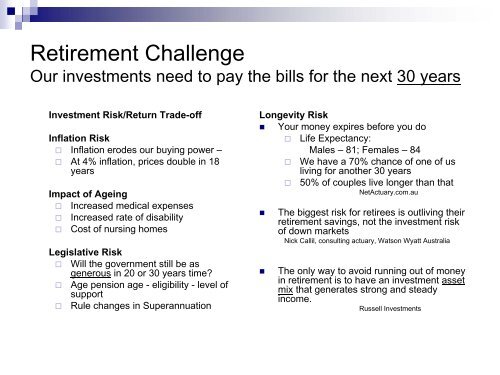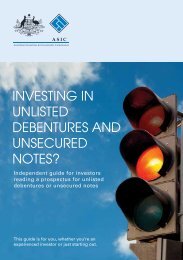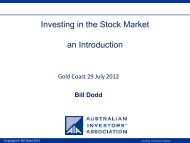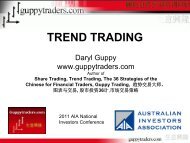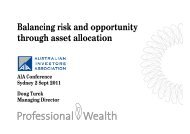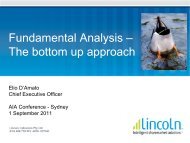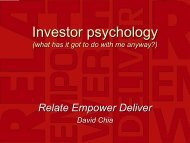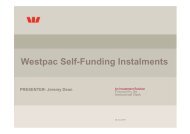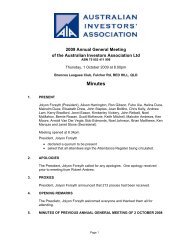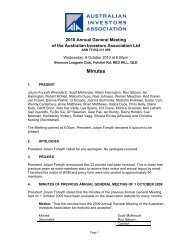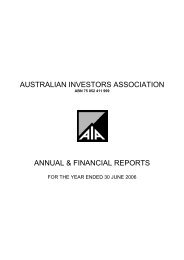How I would invest $1Million in my SMSF - Australian Investors ...
How I would invest $1Million in my SMSF - Australian Investors ...
How I would invest $1Million in my SMSF - Australian Investors ...
You also want an ePaper? Increase the reach of your titles
YUMPU automatically turns print PDFs into web optimized ePapers that Google loves.
Retirement Challenge<br />
Our <strong><strong>in</strong>vest</strong>ments need to pay the bills for the next 30 years<br />
Investment Risk/Return Trade-off<br />
Inflation Risk<br />
Inflation erodes our buy<strong>in</strong>g power –<br />
At 4% <strong>in</strong>flation, prices double <strong>in</strong> 18<br />
years<br />
Impact of Age<strong>in</strong>g<br />
Increased medical expenses<br />
Increased rate of disability<br />
Cost of nurs<strong>in</strong>g homes<br />
Legislative Risk<br />
Will the government still be as<br />
generous <strong>in</strong> 20 or 30 years time?<br />
Age pension age - eligibility - level of<br />
support<br />
Rule changes <strong>in</strong> Superannuation<br />
Longevity Risk<br />
• Your money expires before you do<br />
Life Expectancy:<br />
Males – 81; Females – 84<br />
We have a 70% chance of one of us<br />
liv<strong>in</strong>g for another 30 years<br />
50% of couples live longer than that<br />
NetActuary.com.au<br />
• The biggest risk for retirees is outliv<strong>in</strong>g their<br />
retirement sav<strong>in</strong>gs, not the <strong><strong>in</strong>vest</strong>ment risk<br />
of down markets<br />
Nick Callil, consult<strong>in</strong>g actuary, Watson Wyatt Australia<br />
• The only way to avoid runn<strong>in</strong>g out of money<br />
<strong>in</strong> retirement is to have an <strong><strong>in</strong>vest</strong>ment asset<br />
mix that generates strong and steady<br />
<strong>in</strong>come.<br />
Russell Investments
Investment Risk / Return Trade-off
Asset allocation: the most important decision<br />
Investment return or risk management or both?<br />
If I am a trader<br />
• trade on the prospect of a sell<strong>in</strong>g at a<br />
higher price<br />
Risk is volatility <strong>in</strong> market prices<br />
• traders carefully manage this risk<br />
Managed funds are active traders<br />
• so are their clients<br />
Risk Profile sets the Asset Allocation<br />
• Conservative / Balanced / Assertive /<br />
Aggressive<br />
• Appetite for volatility<br />
Risk Management<br />
• For clients, the only risk protection<br />
aga<strong>in</strong>st volatility:<br />
A more conservative portfolio<br />
(asset allocation)<br />
The effect<br />
• Reduced exposure to growth assets<br />
reduces effects of volatility<br />
M<strong>in</strong>imize downside<br />
Also m<strong>in</strong>imize upside<br />
Lower return long-term<br />
<br />
Longevity risk<br />
Note<br />
• Long-term <strong><strong>in</strong>vest</strong>ment returns are<br />
largely set by asset allocation<br />
(risk profile)
Asset allocation: the most important decision<br />
Investment return or risk management or both?<br />
We <strong><strong>in</strong>vest</strong> <strong>in</strong> shares for Income<br />
• Invest on the prospect of profits<br />
• Income security <strong>in</strong> retirement is critical<br />
Our risk is lower than expected returns<br />
• Our <strong>in</strong>come depends on company<br />
profits<br />
• Blue Chip Shares provide can secure<br />
(reliable) <strong>in</strong>come<br />
<br />
Especially <strong>in</strong>side a <strong>SMSF</strong><br />
With <strong>in</strong>come security<br />
• We are never forced to sell assets<br />
Risk Management<br />
We manage our <strong>in</strong>come security risk with<br />
• a reliable <strong>in</strong>come stream<br />
careful selection of assets<br />
• a cash reserve for safety to smooth<br />
out cash flows<br />
We have no need to manage volatility<br />
• If we set our asset allocation to<br />
manage volatility we <strong>in</strong>crease our<br />
longevity risk<br />
• But volatility is not a risk!<br />
• Volatility is not a risk to<br />
profits/dividends nor our <strong>in</strong>comes<br />
• Invest<strong>in</strong>g <strong>in</strong> shares is much less<br />
stressful<br />
• The biggest risk for retirees is outliv<strong>in</strong>g their<br />
retirement sav<strong>in</strong>gs, not the <strong><strong>in</strong>vest</strong>ment<br />
(volatility) risk of down markets<br />
• Volatility is temporary<br />
• Runn<strong>in</strong>g of money is permanent
Blue Chip Shares<br />
Dividends are a reliable source of <strong>in</strong>come<br />
Retire Early 2010<br />
www.allenwealth.com.au
Blue Chip Shares:<br />
Capital growth as well as grow<strong>in</strong>g dividends<br />
Would you sell this <strong>in</strong>come generat<strong>in</strong>g<br />
mach<strong>in</strong>e?
Dividends are closely l<strong>in</strong>ked to company earn<strong>in</strong>gs<br />
– Payout Ratio<br />
AMP Capital <strong>Investors</strong>
Income from “risky” shares<br />
compared to “safe” term deposits<br />
Peter Thornhill – Motivated Money
Dividends are less volatile than share prices<br />
Andrew Page - Hubb F<strong>in</strong>ancial
Invest<strong>in</strong>g <strong>in</strong> shares for <strong>in</strong>come lowers our risk<br />
• Dividends are paid from company<br />
profits – remarkably stable<br />
a signal of f<strong>in</strong>ancial strength<br />
cash is k<strong>in</strong>g<br />
• Company profits grow over time<br />
Dividends pay the highest <strong>in</strong>come<br />
over time<br />
Our <strong>in</strong>come stream is low risk:<br />
• Stable, predictable, reliable<br />
• Regular payments<br />
• A perpetual “bond”<br />
• Grow<strong>in</strong>g faster than <strong>in</strong>flation<br />
• A term deposit on steroids<br />
• Dividends/earn<strong>in</strong>gs are much more<br />
reliable - less volatile than share prices<br />
• Dividends = money <strong>in</strong> the bank<br />
Capital ga<strong>in</strong>s = maybe money<br />
• Our risk is a fall <strong>in</strong> earn<strong>in</strong>gs/dividends<br />
Our risk is not price volatility<br />
Our longevity risk is lower:<br />
• A much greater growth asset<br />
allocation than a balanced fund<br />
• Higher likely long-term return<br />
• Less likely to run out of money<br />
• More likely to leave an <strong>in</strong>heritance for<br />
the kids
An actuarial view of asset allocation<br />
For superannuation fund members:<br />
David Kerr “Risk – What Risk?”<br />
ACTUARY AUSTRALIA NOVEMBER 2007<br />
• (a) equities are a more<br />
conservative asset class than<br />
fixed <strong>in</strong>terest<br />
• (b) volatility of capital is not a<br />
significant risk<br />
• (c) diversify<strong>in</strong>g assets to reduce<br />
volatility (a non-risk element) at<br />
the expense of long-term return<br />
(a risk element) actually <strong>in</strong>creases<br />
risk<br />
• So anyone who <strong>in</strong>cludes fixed<br />
<strong>in</strong>terest <strong>in</strong> their asset mix to cover<br />
retirement sav<strong>in</strong>gs is probably<br />
<strong>in</strong>creas<strong>in</strong>g volatility, lower<strong>in</strong>g<br />
return and <strong>in</strong>creas<strong>in</strong>g the risk of<br />
not sav<strong>in</strong>g enough<br />
• Any trustee that does not provide<br />
a low-risk (100% share)<br />
<strong><strong>in</strong>vest</strong>ment option is expos<strong>in</strong>g their<br />
members to unacceptable risk
ASX Blue Chip 10 Year Performance<br />
Companies with great earn<strong>in</strong>gs<br />
RBS Morgans<br />
Company 10 yr Compound Return Dividend Capital<br />
ANZ 12.8% 42% 58%<br />
ASX 12.7% 34% 66%<br />
BHP 19.8% 13% 87%<br />
CBA 12.4% 38% 62%<br />
CSL 18.3% 9% 91%<br />
LEI 26.2% 18% 82%<br />
NAB 7.5% 72% 28%<br />
ORG 31.4% 11% 89%<br />
PPT 11.5% 63% 37%<br />
QBE 15.3% 34% 66%<br />
RIO 16.6% 15% 85%<br />
TOL 24.9% 18% 82%<br />
WBC 12.8% 38% 62%<br />
WES 15.6% 39% 61%<br />
WOW 21.4% 19% 81%<br />
WPL 18.5% 20% 80%<br />
Average 17.0% 30% 70%
Asset Allocation<br />
• If you have <strong>in</strong>come security and a 30<br />
years time horizon<br />
<br />
You should have a growth asset<br />
allocation<br />
• In retirement, we also have a secure<br />
<strong>in</strong>come and a 30 year time horizon<br />
<br />
<br />
A cash reserve for safety<br />
All of our rema<strong>in</strong><strong>in</strong>g funds can be<br />
allocated to shares for both <strong>in</strong>come and<br />
growth<br />
• Assume our <strong>in</strong>come needs = $50,000 pa<br />
Cash reserve (2 years) $100,000 (10%) $100,000 (5%)<br />
Shares for <strong>in</strong>come $900,000 (90%) $1,900,000 (95%)<br />
Total $1,000,000 (100%) $2,000,000 (100%)<br />
• If this was a balanced fund, 30% or more <strong>would</strong> be allocated to cash/bonds<br />
• That seems a lot of growth to forfeit to manage volatility risk when this is not a risk for<br />
<strong>in</strong>come <strong><strong>in</strong>vest</strong>ors
Example Portfolio: Julia & Tim Super Fund Est. 11 Nov 2010<br />
<strong>How</strong> much <strong>in</strong>come this year?<br />
Co Qty Cost Total Div -11 Dividends Yield Rate Frank Unfrank Credit Gross Yield<br />
ANZ 4000 $23.72 $94,880.00 $1.48 $5,920.00 6.24% 100% $5,920.00 $0.00 $2,537.14 $8,457.14 8.91%<br />
BHP 2000 $44.59 $89,180.00 $1.18 $2,360.00 2.65% 100% $2,360.00 $0.00 $1,011.43 $3,371.43 3.78%<br />
LEI 3000 $32.10 $96,300.00 $1.50 $4,500.00 4.67% 100% $4,500.00 $0.00 $1,928.57 $6,428.57 6.68%<br />
MYR 25000 $3.89 $97,250.00 $0.24 $6,000.00 6.17% 100% $6,000.00 $0.00 $2,571.43 $8,571.43 8.81%<br />
NAB 4000 $24.15 $96,600.00 $1.58 $6,320.00 6.54% 100% $6,320.00 $0.00 $2,708.57 $9,028.57 9.35%<br />
QBE 5500 $16.68 $91,740.00 $1.28 $7,040.00 7.67% 20% $1,408.00 $5,632.00 $603.43 $7,643.43 8.33%<br />
TAH 10000 $7.35 $73,500.00 $0.44 $4,400.00 5.99% 100% $4,400.00 $0.00 $1,885.71 $6,285.71 8.55%<br />
TOL 12000 $6.11 $73,320.00 $0.23 $2,760.00 3.76% 100% $2,760.00 $0.00 $1,182.86 $3,942.86 5.38%<br />
WES 3000 $33.31 $99,930.00 $1.90 $5,700.00 5.70% 100% $5,700.00 $0.00 $2,442.86 $8,142.86 8.15%<br />
WOW 3000 $28.10 $84,300.00 $1.30 $3,900.00 4.63% 100% $3,900.00 $0.00 $1,671.43 $5,571.43 6.61%<br />
CASH $100,000.00 $6,000.00 6.00% 0% $0.00 $6,000.00 $0.00 $6,000.00 6.00%<br />
TOTAL $997,000.00 $54,900.00 5.51% $18,543.43 $73,443.43 7.37%<br />
<strong>How</strong> much <strong>in</strong>come next year?
We <strong><strong>in</strong>vest</strong> <strong>in</strong> shares for <strong>in</strong>come<br />
rather than property<br />
Dividends provide:<br />
• Income Yield<br />
• Favourable tax treatment<br />
• Liquidity & Diversification<br />
• Low cost of ownership<br />
• Passive <strong><strong>in</strong>vest</strong><strong>in</strong>g<br />
<br />
Ease of management<br />
• Income + Growth<br />
<br />
<br />
Growth asset - not just <strong>in</strong>flation but<br />
productivity - l<strong>in</strong>ked to the econo<strong>my</strong><br />
Grow<strong>in</strong>g Income Stream<br />
• Perpetual <strong>in</strong>come stream<br />
<br />
We should never need to draw capital<br />
Inside a <strong>SMSF</strong>:<br />
• A pension fund pays no tax on <strong>in</strong>come<br />
or capital ga<strong>in</strong>s<br />
• The fund gets a tax refund for<br />
imputation credits<br />
• Actual <strong>in</strong>come is the dividend PLUS<br />
the tax credit<br />
<br />
<br />
Higher gross yield – less capital<br />
needed<br />
Income security<br />
• Pension payments are tax free<br />
(over 60)<br />
<br />
Does not appear on tax return<br />
• Non-super <strong>in</strong>come benefits from taxfree<br />
threshold and tax offsets
Our <strong>SMSF</strong> – In Operation<br />
Simplicity itself<br />
Our <strong>SMSF</strong> holds only <strong>Australian</strong> shares and a cash reserve<br />
• A cash reserve for safety held <strong>in</strong> <strong>SMSF</strong> bank account or term deposit<br />
• All shares held directly by <strong>SMSF</strong> – no managed <strong><strong>in</strong>vest</strong>ments<br />
• As trustees we make all <strong><strong>in</strong>vest</strong>ment decisions – use a full-service broker<br />
M<strong>in</strong>imum costs/no fees<br />
• Once-only brokerage – No fees paid to fund managers or advisers<br />
• We use an adm<strong>in</strong>istrator for compliance, tax return and paperwork: on-go<strong>in</strong>g fixed fee<br />
<strong>SMSF</strong> funds our lifestyle<br />
• All <strong>in</strong>come is paid <strong>in</strong>to <strong>SMSF</strong> bank account<br />
<br />
<br />
Dividends are paid twice per year<br />
Imputation credits are refunded annually by ATO<br />
• Pensions drawn from <strong>SMSF</strong> bank account - at least the m<strong>in</strong>imum, at least once per year<br />
• Any <strong>in</strong>come above the m<strong>in</strong>imum is discretionary - lifestyle or re<strong><strong>in</strong>vest</strong><br />
We call this our orchard<br />
• Our shares can be expected to generate even more <strong>in</strong>come next year<br />
That gives us peace of m<strong>in</strong>d<br />
--ooOoo--


